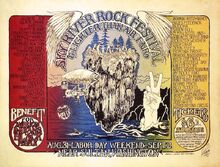







The Sky River Rock Festival and Lighter Than Air Fair, was organised in Seattle and staged near the farmland town of Sultan, Washington.
The Sky River Rock Festival was conceived sometime circa May 1968 by several cognoscenti of Seattle’s counterculture, most of whom were on the staff of Helix, at the time Seattle’s reigning countercultural newspaper. The festival’s main inspiration was the historic Duvall Piano Drop, held the previous month in nearby Duvall, Washington. At that event, a helicopter dropped an upright piano onto a rural pasture to demonstrate for a large audience what the resulting cacophony would sound like. While the piano merely made an anticlimactic thud, the event also crucially included a musical act as part of the day’s entertainment: namely, Country Joe and the Fish. The event was enough of an overall success to cause Paul Dorpat, publisher and co-editor of Helix, to speculate aloud, “If 3,000 people come to hear one band, how many would come to hear a dozen, or two dozen, or . . . ?”
Thus, the Pacific Northwest’s first outdoor rock festival was conceived. The planning began informally during private social gatherings in Seattle’s University District (then the home of the Helix headquarters) and culminated when several people gathered at a house in Seattle’s Wallingford neighborhood to brainstorm the proposed event and decide upon a name. According to Helix co-editor and illustrator Walt Crowley (1947-2007), that group included Dorpat, Crowley, Scott White, Gary Finholt, John Bixler, John Cunnick, Tim Harvey, and possibly the future famous novelist Tom Robbins.
Among the key organizers who would soon join the project was John Chambless, a University of Washington philosophy lecturer who had been a graduate student at the University of California at Berkeley prior to moving to Seattle. While in school at Berkeley, Chambless was one of the principal organizers of the Berkeley Folk Festival, and this accounts for the multitude of San Francisco bands who would eventually appear at the Sky River festival, since Chambless already knew many of those bands and their managers.
The site chosen for the festival was a 40-acre pasture on the banks of the Skykomish River, just outside Sultan, owned by Betty Nelson, a rural bohemian who responded to an ad in Helix announcing plans for the festival and seeking a suitable location for the event. The site was a natural amphitheater enclosed by woods, and the festival’s name was derived from the name of the nearby river.
It remains unclear today who actually performed at the festival, due to the haphazard nature of the planning; thus, historical accounts vary. Tickets went on sale in mid-July before a single act had been booked; meanwhile, the organizers scrambled to sign up acts. Country Joe and the Fish — reprising their role in the Duvall Piano Drop — were among the first acts to sign up, and as the event drew near, Walt Crowley’s official poster for the event listed 40 confirmed acts.
Among the bands and performers booked for the festival were Santana, Big Mama Thornton, James Cotton, Country Joe and the Fish, Richard Pryor, Dino Valenti, Byron Pope, It’s a Beautiful Day, Peanut Butter Conspiracy, Alice Stuart Thomas, the Youngbloods, the New Lost City Ramblers, and local groups such as Juggernaut and Easy Chair. The “Lighter Than Air Fair” referred to the hot-air balloon rides that were offered as part of the festivities. (Unfortunately, the single balloon originally acquired for the event floated away in apparent mutiny before a single rider could enjoy the experience; frantic phone calls located a last-minute replacement in Spokane.)
Overall, the event proved to be a stunning success, likely beyond what the organizers first imagined. Some 13,000 paying customers were joined by several thousand gate-crashers. Yes, it rained — yet no one there seemed to mind. On the final day of the festival, September 2, the Grateful Dead arrived unscheduled and unexpected. They reportedly heard about the festival by word of mouth earlier that weekend and flew up to Seattle just in time to perform.
The Sky River Rock Festival was successful enough that it was repeated the following summer, this time near the town of Tenino, Washington, south of Olympia. Although it did not continue after its third staging in 1970, its legend was a major inspiration for the creation of Bumbershoot, the popular Labor Day weekend music and arts festival that was launched in 1971 and continues to the present day.